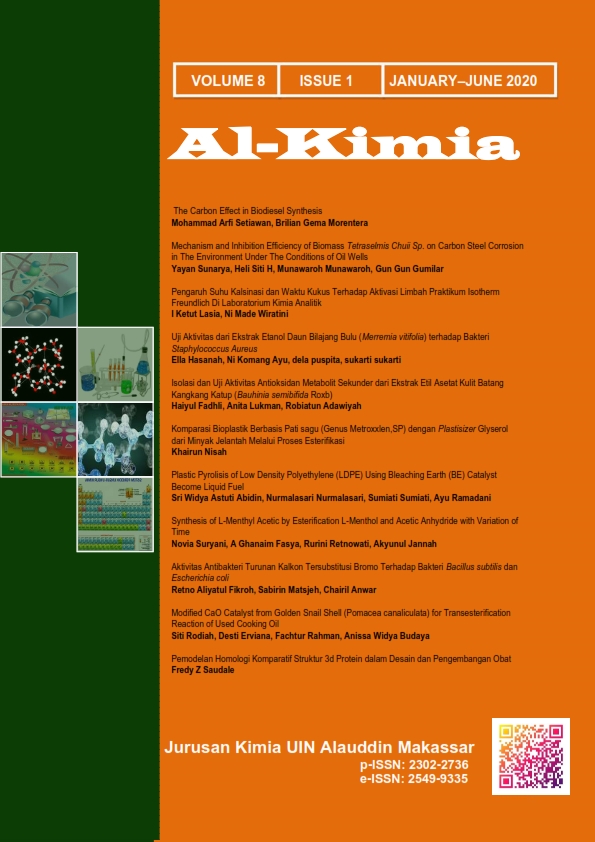Aktivitas Antibakteri Turunan Kalkon Tersubstitusi Bromo Terhadap Bakteri Bacillus subtilis dan Escherichia coli
Abstract
Pengembangan obat antibiotik dalam menanggulangi penyakit akibat infeksi bakteri semakin meluas. Hal ini diiringi dengan semakin meningkatnya prevalensi retensi terhadap antibiotik. Banyaknya kasus retensi terhadap antibiotik menyebabkan perlu dilakukan pengembangan agen antibakteri yang salah satunya berasal dari senyawa turunan kalkon. Sintesis senyawa turunan kalkon yang memiliki aktivitas dalam menghambat bakteri Bacillus subtilis dan Escerichia coli telah dilakukan. Sintesis senyawa (E)-2’-hidroksi-2-bromo-4,5-dimetoksikalkon melalui reaksi kondensasi Claisen-Schmidt dari senyawa 2-hidroksiasetofenon dengan 2-bromo-4,5-dimetoksibenzaldehida.. Sintesis dilakukan dengan metode refluks dalam kondisi basa menggunakan katalis NaOH dan metanol sebagai pelarut selama 24 jam. Struktur hasil sintesis senyawa turunan kalkon dianalisis dengan FTIR, KLT-scanner, GC-MS, MS-direct, 1H-NMR dan 13C-NMR. Uji antibakteri dilakukan dengan metode difusi cakram (sumuran) terhadap bakteri Bacillus subtilis dan Escherichia coli. Seri konsentrasi senyawa meliputi 1%, 5%, 10%, dan 20% serta digunakan kontrol positif 4-isopropil-3-metilfenol 1%. Hasil penelitian menunjukkan bahwa sintesis senyawa turunan kalkon menghasilkan padatan berwarna kuning dengan rendemen sebesar 78,45%. Daya hambat senyawa kalkon dan 4-isopropil-3-metilfenol sebagai kontrol positif hampir sama untuk kedua bakteri yaitu 15 mm untuk Bacillus substilis dan 13 mm untuk Escherichia coli. Selain itu, uji daya hambat senyawa turunan kalkon terhadap bakteri Bacillus substillis lebih baik dibandingkan pada bakteri Escherichia coli pada konsentrasi 20% dengan zona hambat berturut-turut sebesar 19,7 dan 17,7 nm.
Downloads
References
Achanta, G,. Modzelewska, A., Feng, L,. Khan, S.R,. & Huang, P., (2006), boronic chalcone derivative exhibits potent anticancer activity through inhibition of the proteasome, Molecular prarmacol, 70: 426-433.
Bhuiyan, M.M.H., Hossain, M.I., Mahmud, M.M., & Amin, MA., (2011), Microwave-assisted efficient synthesis of chalcones as probes for antimicrobial activities, Chemistry journal, 1(1): 21-28.
Choudharya, A.N., and Juyal, V., (2011), Synthesis of chalcone and their derivatives as antimicrobial agents, Int. J. Pharm. Pharm. Sci., 3(3): 125-128.
Davis, W.W., and Stout, T.R., (1971), disc plate methods of microbiological antibiotic assay, App. Microbioll., 22(4): 659-665.
Jasril, Teruna, H.Y., Zamri, A., Alfatos, D., Yuslinda, E., & Nurulita, Y., (2012), sintesis dan uji antibakteri senyawa bromo kalkon piridin, Jurnal Natur Indonesia, 14(3); 172-175.
Lahtchev, K.L., Batovska, D.I., Parushev, St.P., Ubiyvovk, V.M., & Sibirny, A.A., (2008), Antifungal activity of chalcones: a mechanistic study using various yeast strains, European journal of medicinal chemistry, 43: 2220-2228.
Nugraha, H.P., (2015), Sintesis dan uji aktivitas antibakteri senyawa pirazolina berbahan dasar 3-metoksi-4-hidroksibenzaldehida (vanilin) dan 4-metoksibenzaldehida (p-anisaldehida), Skripsi, FMIPA Universitas Gadjah Mada.
Prasad, Y.R., Rao, A.L., & Rambabu, R., (2008), Synthesis and antimicrobial activity of some chalcone derivatives, E-Journal of Chemistry, 5(3): 461-466.
Prasad, Y.R., Kumar, P.R., Deepti, C.A., & Ramana, M.V., (2006), Synthesis and antimicrobial activity of some novel chalcones of 2-hydroxy-1- acetonapthoneand 3-acetyl coumarin, E-Journal of Chemistry. 3(13): 236-241.
Shorey, S., Choudhary, P. C., and Intodia, K., (2013), Microwave irradiation synthesis of various substituted chalcones using various heterogeneous catalysts under solvent-free conditions and their biological studies, Chem. Sci. Trans., 2(2), 343-348.
Silverstein, R. M., Webster, F. X., and Kiemle, D. J., (2005), Spectrometric Identification of Organic Compound, John Wiley & Son Inc., New York.
Wu, J.H., Wang, X.H., Yi, Y.H., & Lee, K.H., (2003), Anti-aids agents 54 a potent anti-hiv chalcone and flavonoids from genus desmos, Bioorg. Med. Chem. Lett., 13(10): 1813-1815.
Copyright (c) 2020 Retno Aliyatul Fikroh

This work is licensed under a Creative Commons Attribution-NonCommercial-ShareAlike 4.0 International License.
Authors who publish with this journal agree to the following terms:
1) Authors retain copyright and grant the journal right of first publication with the work simultaneously licensed under a Creative Commons Attribution License that allows others to share the work with an acknowledgement of the work's authorship and initial publication in this journal.
2) Authors are able to enter into separate, additional contractual arrangements for the non-exclusive distribution of the journal's published version of the work (e.g., post it to an institutional repository or publish it in a book), with an acknowledgement of its initial publication in this journal.
3)Authors are permitted and encouraged to post their work online (e.g., in institutional repositories or on their website) prior to and during the submission process, as it can lead to productive exchanges, as well as earlier and greater citation of published work (See The Effect of Open Access).


